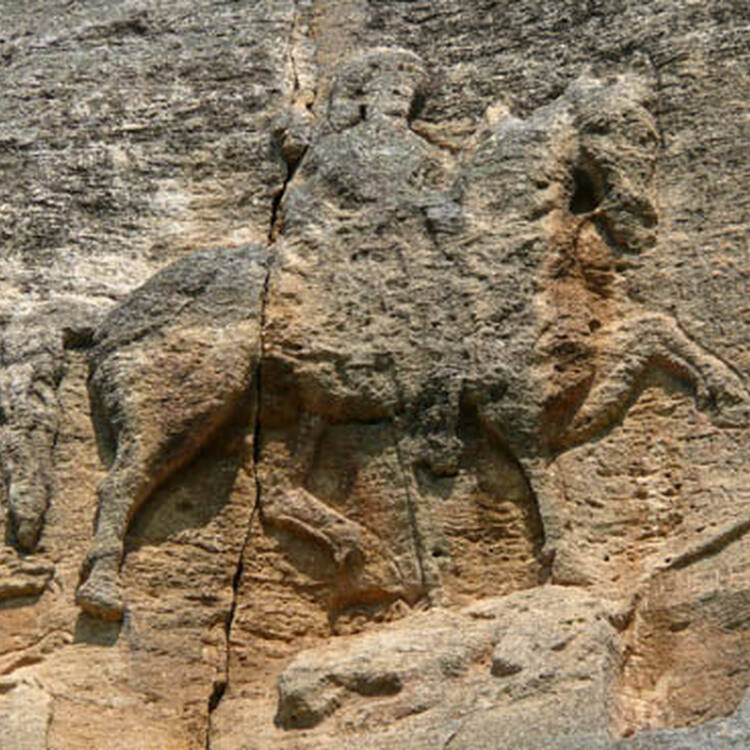Madara Rider
Madara Rider
The Madara Rider, representing the figure of a knight triumphing over a lion, is carved into a 100-m-high cliff near the village of Madara in north-east Bulgaria. Madara was the principal sacred place of the First Bulgarian Empire before Bulgaria’s conversion to Christianity in the 9th century. The inscriptions beside the sculpture tell of events that occurred between AD 705 and 801.
Description is available under license CC-BY-SA IGO 3.0
Cavalier de Madara
Le Cavalier de Madara, représentant un cavalier vainqueur d’un lion, est sculpté sur une falaise de 100 m de haut, près du village de Madara, dans le nord-est de la Bulgarie. Madara a été le premier lieu sacré du premier Empire bulgare, avant la conversion de la Bulgarie au IXe siècle. Les inscriptions qui figurent à côté de cette sculpture relatent des événements survenus entre 705 et 831.
Description is available under license CC-BY-SA IGO 3.0
فارس مادارا
يجسّد تمثال فارس مادارا فارساً يتغلّب على أحد الأسود وهو منحوت في جرف صخري يبلغ علوه 100 متر، بالقرب من بلدة مادارا، في شمال شرق بلغاريا. شكّلت مادارا أول مكان عبادة في الإمبراطورية البلغارية الأولى، قبل اعتناق بلغاريا الديانة المسيحية في القرن التاسع. وتسرد الكتابات المحفورة بجانب هذا التمثال بعض الأحداث التي جرت بين عامَي 705 و813.
source: UNESCO/CPE
Description is available under license CC-BY-SA IGO 3.0
马达腊骑士崖雕
马达腊骑士崖雕刻画的是一位骑士斗败狮子的场面,位于保加利亚东北部马达腊镇附近的一面高约100米的悬崖之上。在公元9世纪前,保加利亚人并不信仰基督教,那时马达腊是保加利亚第一帝国主要的宗教场所。在崖雕的边上还刻有铭文,讲述了公元705年至801年间发生的事件。
source: UNESCO/CPE
Description is available under license CC-BY-SA IGO 3.0
Мадарский всадник
Мадарский всадник – это фигура воина, побеждающего льва, вырезанная в утесе около деревни Мадара на северо-востоке Болгарии. Мадара была главным священным местом первого Болгарского царства до того, как Болгария в ХI в. приняла христианство. Надписи поблизости от скульптуры сообщают о событиях, которые происходили в этой местности между 705 и 801 гг.
source: UNESCO/CPE
Description is available under license CC-BY-SA IGO 3.0
El Caballero de Madara
El Caballero de Madara es una figura esculpida en un peñasco de 100 metros de altura, que representa un jinete vencedor de un león. Recibe su nombre de la cercana aldea de Madara, situada al noreste de Bulgaria. Madara fue el lugar sagrado más importante del primer Imperio Búlgaro, antes de la conversión de este país al cristianismo en el siglo IX. Las inscripciones que acompañan la escultura relatan acontecimientos ocurridos entre los años 705 y 813 d.C.
source: UNESCO/CPE
Description is available under license CC-BY-SA IGO 3.0
マダラの騎士像
source: NFUAJ
Madara ruiter
Source: unesco.nl
Outstanding Universal Value
Brief synthesis
The Madara Rider is a unique relief, an exceptional work of art, created during the first years of the formation of the Bulgarian State, at the beginning of the 8th century. It is the only relief of its kind, having no parallel in Europe. It has survived in its authentic state, with no alternation in the past or the present.
It is outstanding not only as a work of Bulgarian sculpture, with its characteristically realist tendencies, but also as a piece of historical source material dating from the earliest years of the establishment of the Bulgarian state. The inscriptions around the relief are, in fact, a chronicle of important events concerning the reigns of very famous Khans: Tervel, Kormisos and Omurtag.
Criterion (i): The Madara Rider is an exceptional work of art dating from the beginning of the 8th century. It is the only relief of its kind, having no parallel in Europe.
Criterion (iii): The Madara Rider is outstanding not only as a work of the realist Bulgarian sculpture but also as a piece of historical source material from the earliest years of the Bulgarian state, since the inscriptions around the relief chronicle events in the reigns of famous Khans.
Integrity
The rock relief of the Madara Horseman encompass within its boundaries sufficient elements for its presentation. It lies within an archaeological reserve that includes other archaeological monuments, up to 2000 years old. The defined boundaries, and the protection zone, ensure the conservation of the property's surrounding.
Due to the uncertain stability of the supporting rock, the relief has a serious and enduring conservation problem, although changes in the integrity of the property are not significant. A combination of wind erosion, and surface water run-off from heavy rain and melting snow, together with biological coatings, is causing the rock to erode. The property has been subject to numerous archaeological, geodesic, geological, hydrological, static, seismograph, physical chemistry and, lately, microbiological research investigations. These exceptional research efforts have been incorporated into a database, the results of which have defined the parameters for immediate conservation interventions. In 2007 an international project, seeking solutions for the conservation of the relief, was concluded and an evaluation of proposed interventions is pending.
Authenticity
The form and design, location and setting, materials and substance, and spirit and feeling of the Madara Horseman relief have retained their authenticity.
Protection and management requirements
Management is implemented by virtue of:
- Cultural Heritage Law (Official Gazette No.19 of 2009) and subdelegated legislation. This law regulates the research, studying, protection and promotion of the immovable cultural heritage in Bulgaria, and the development of Conservation and Management plans for its inscribed World Heritage List of immovable cultural properties.
In addition, secondary legislation, issued by the Government in 1981 (Ordinance No. 22 on Protection of the Historical and Archaeological Reserves of Pliska, Preslav and Madara, promulgated in the Official Gazette No. 14 of 1981) also applies.
In order to ensure the conservation of the relief, there is a need to implement the proposed interventions drawn by the 2007 International project.

 View photos from OUR PLACE the World Heritage collection
View photos from OUR PLACE the World Heritage collection